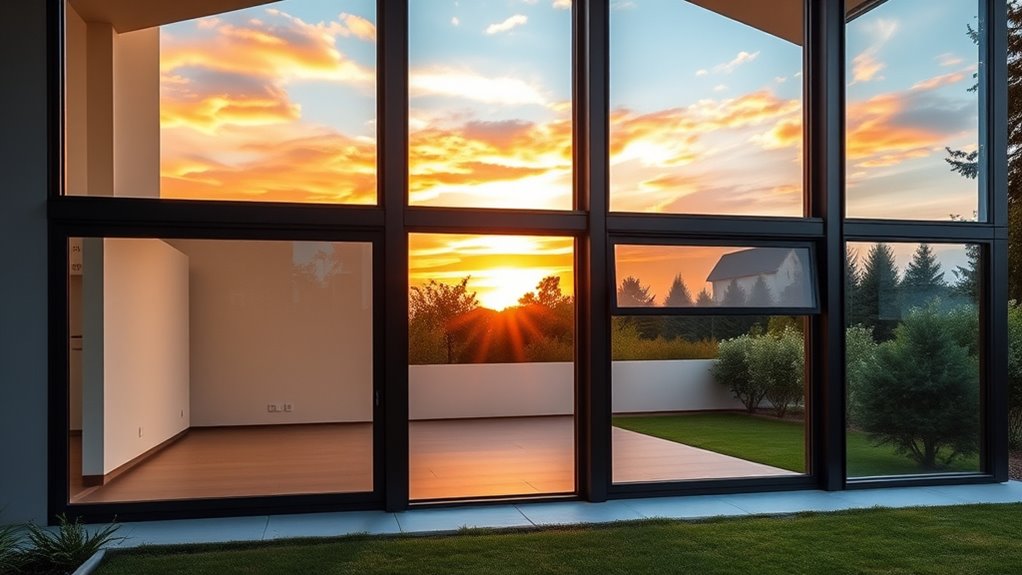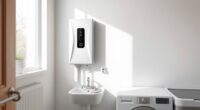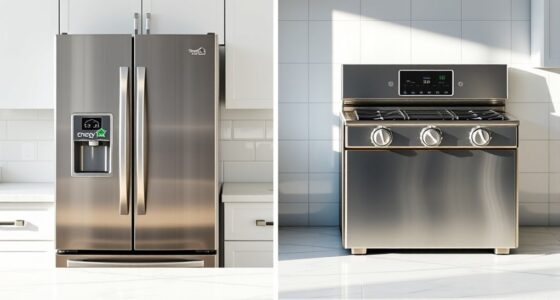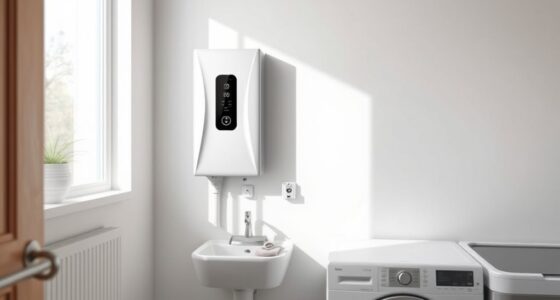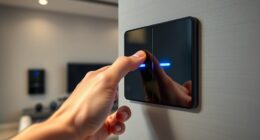Choosing energy-efficient windows for your modern home involves selecting the right combination of materials and glass technology. Opt for vinyl or fiberglass frames with low-emissivity coatings and double- or triple-pane glass filled with inert gases like argon for ideal insulation. Properly designed windows can reduce your energy bills, increase comfort, and lower your environmental impact. To discover the best options tailored to your climate and needs, explore the detailed benefits and features further.
Key Takeaways
- Choose windows with Low-E coatings and multiple panes, such as double or triple glazing, for enhanced insulation.
- Opt for energy-efficient frame materials like fiberglass or vinyl that offer low thermal conductivity.
- Incorporate inert gas fills (argon or krypton) between panes to improve thermal performance.
- Consider window orientation and select coatings to optimize solar gain and minimize unwanted heat transfer.
- Prioritize high-quality, certified windows to ensure long-term energy savings and increased home comfort.
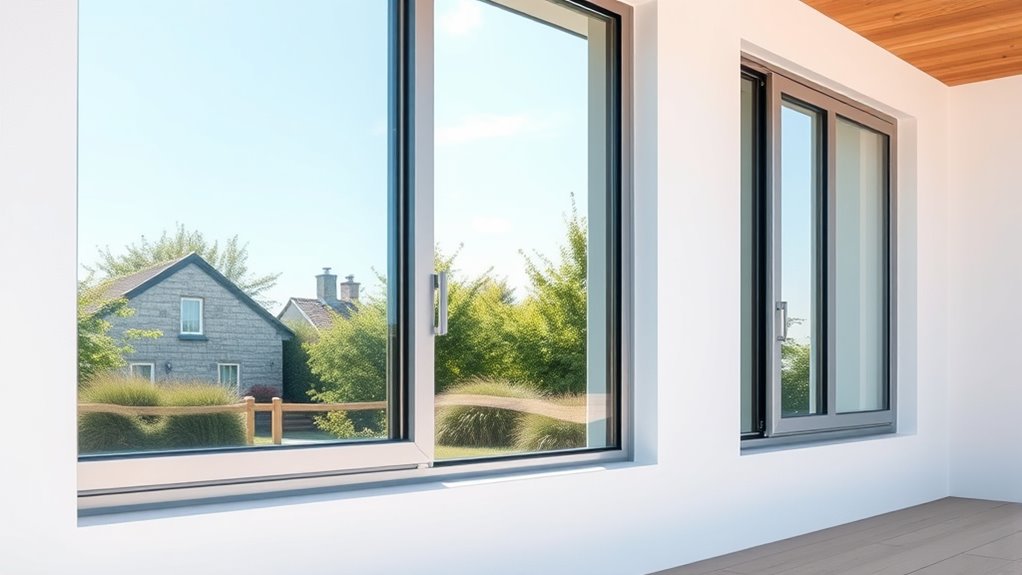
When choosing windows for your home, energy efficiency should be a top priority because it can considerably reduce your heating and cooling costs. The first thing to consider is the window frame materials, which play a crucial role in insulation and durability. Vinyl frames are popular for their low maintenance, affordability, and good insulating properties. They resist moisture and won’t warp or corrode over time, making them an energy-efficient choice. Wood frames offer excellent insulation but require more upkeep to prevent rot and damage. Aluminum frames are durable but tend to conduct heat and cold easily, which can lead to higher energy costs unless they’re thermally broken with a plastic or resin spacer. Fiberglass frames strike a balance, providing strength, low thermal conductivity, and minimal maintenance, making them a smart option for energy-conscious homeowners.
Beyond the frame, the glass itself significantly impacts energy efficiency. Modern glass coating technologies, such as low-emissivity (Low-E) coatings, are designed to reflect heat while allowing light to pass through. These coatings help keep warm air inside during winter and block heat from entering during summer, reducing the strain on your HVAC system. Some advanced coatings also selectively filter out ultraviolet rays, protecting your furniture and flooring from fading while maintaining natural light. Multiple-pane glass units, such as double or triple glazing, further enhance insulation. These units often contain inert gases like argon or krypton between panes, which provide additional resistance to heat transfer. When combined with Low-E coatings, multi-glazed windows create a highly efficient barrier against temperature fluctuations. Additionally, understanding the benefits of different frame materials can help you make a more informed choice tailored to your climate and budget.
Modern Low-E coatings and multi-pane glass with inert gases greatly improve window insulation and energy efficiency.
Choosing the right combination of window frame materials and advanced glass coatings can make a substantial difference in your home’s energy performance. For example, pairing fiberglass frames with triple-pane windows featuring Low-E coatings offers superior insulation, especially in colder climates. Conversely, vinyl frames with double-pane, Low-E glass can deliver excellent energy savings in milder regions. It’s also worth considering the window’s design and orientation. South-facing windows can benefit from coatings that maximize solar heat gain in winter, while east- and west-facing windows might require coatings that minimize summer heat.
Ultimately, investing in energy-efficient windows means you’ll enjoy lower utility bills, enhanced comfort, and environmental benefits. By carefully selecting the right window frame materials and glass coating technologies, you ensure your home remains cozy all year round while reducing your carbon footprint. It’s a smart upgrade that pays off over time, blending comfort, savings, and sustainability seamlessly.
Frequently Asked Questions
How Long Do Energy-Efficient Windows Typically Last?
Energy-efficient windows usually last between 15 to 20 years, depending on their window longevity and material durability. If you choose high-quality materials like vinyl or fiberglass, you can expect them to stay in good condition longer. Regular maintenance helps preserve their performance. Keep an eye out for signs of wear, such as drafts or condensation, so you can replace them before they lose their energy-saving benefits.
Are There Government Incentives for Installing Energy-Efficient Windows?
Yes, there are government incentives for installing energy-efficient windows. You can take advantage of government rebates and federal programs that help offset the costs. These incentives are designed to encourage energy-saving upgrades in your home. Check with local or federal agencies to find current offers, as eligibility and amounts vary. Taking advantage of these programs can make upgrading your windows more affordable and environmentally friendly.
Can Energy-Efficient Windows Be Installed in Existing Homes Easily?
Think of installing energy-efficient windows as giving your home a fresh suit—it’s doable but involves some retrofitting challenges. You can install them in existing homes, but expect some hurdles and higher installation costs compared to new builds. With proper planning and a professional team, the process becomes smoother. While it might be an investment, the long-term savings on energy bills make it worthwhile.
How Do Energy-Efficient Windows Impact Home Resale Value?
Energy-efficient windows can boost your home’s resale value and enhance market appeal. When you upgrade, prospective buyers see improved energy savings and modern aesthetics, making your property more attractive. These windows demonstrate your commitment to sustainability and cost-saving benefits, which can set your home apart in a competitive market. Overall, investing in energy-efficient windows increases your property’s desirability and can lead to higher offers when it’s time to sell.
What Maintenance Is Required for Energy-Efficient Windows?
You might think energy-efficient windows require little upkeep, but regular maintenance keeps them performing at their best. You should routinely clean the windows with gentle window cleaning methods to prevent dirt buildup, which can diminish efficiency. Additionally, inspect the sealant around the frames for cracks or gaps—promptly resealing ensures peak insulation. Proper maintenance extends your windows’ lifespan and keeps your home energy-efficient, saving you money in the long run.
Conclusion
Choosing the right energy-efficient windows can substantially cut your heating and cooling costs while making your home more comfortable. With options like Low-E coatings, double or triple glazing, and insulated frames, you have the power to make smarter, eco-friendly choices. Don’t you want a home that’s both stylish and sustainable? Investing in these windows not only saves money but also helps protect the planet—so why wait to upgrade your home’s efficiency today?
